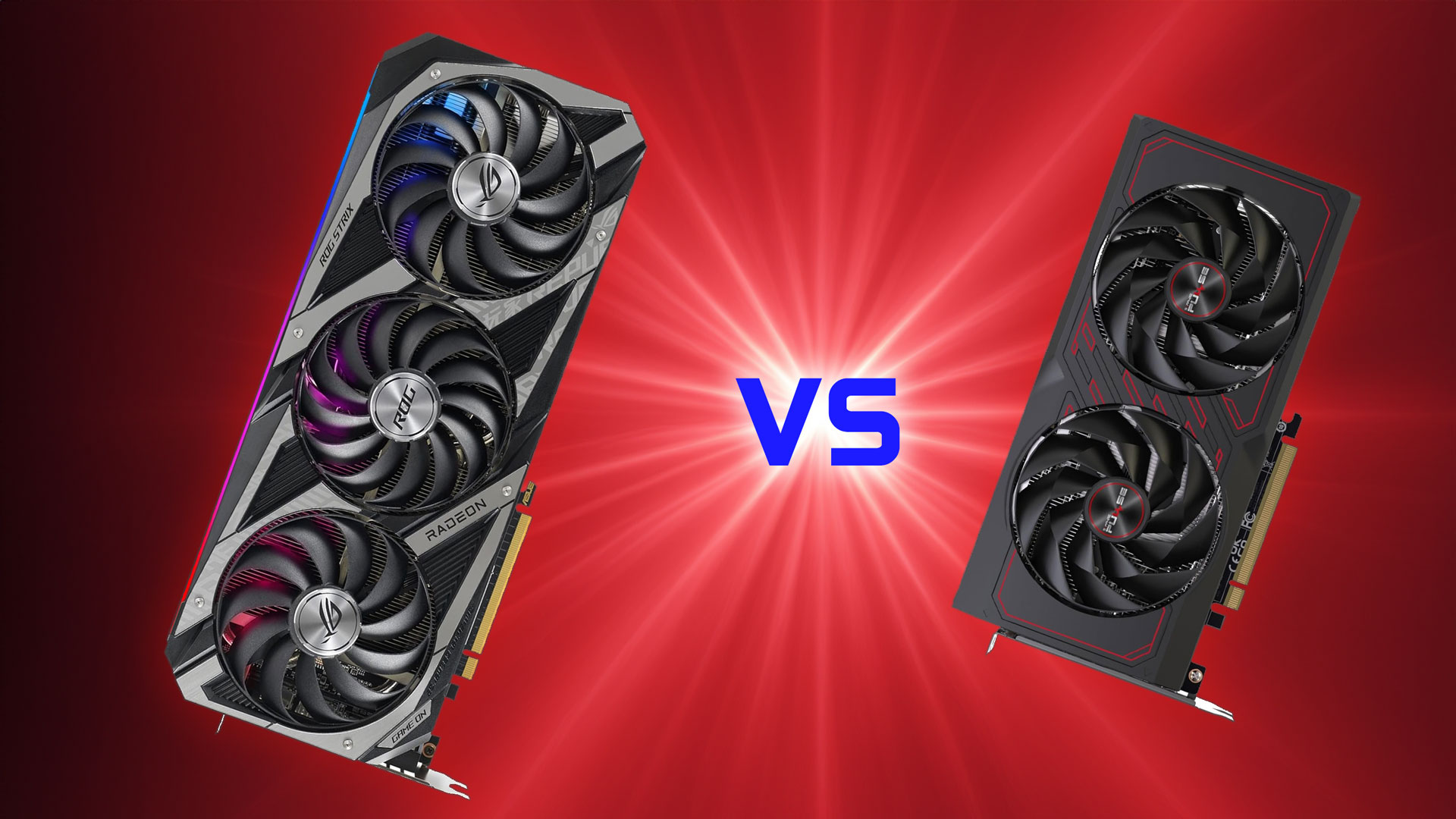
AMD's latest generation RDNA 3 GPUs have struggled at times against the previous generation RDNA 2 offerings, and nowhere is that more apparent than with the arrival of the RX 7600 XT — a 16GB version of the Navi 33 GPU. Its biggest competition comes from the older RX 6750 XT, a red versus red battle for the $300 (give or take) GPU market. We've put the two GPUs together in our very own GPU thunderdome, where two cards enter but only one card can leave victorious.
The RX 7600 XT debuted in January 2024 as a higher-end variant of the RX 7600. Despite this, the RX 7600 XT is more or less a virtual clone of the RX 7600, packing the same Navi 33 die with the same core configuration and memory interface. The only major change is that the RX 7600 XT boasts 16GB of memory, by putting chips on both sides of the PCB; it also has a slightly higher power limit and boosted clocks to help keep it ahead of its sibling.
The RX 6750 XT debuted over two years ago in March 2022. It's a refreshed variant of the RX 6700 XT that came out in August 2021, featuring the same Navi 22 core with the same number of processing clusters, but with faster GDDR6 memory and higher clock speeds. The 6750 XT has largely supplanted it, offering about a 7% bump in performance, though occasionally you can still find a good deal on the 6700 XT.
There are big differences between the RX 6750 XT and the RX 7600 XT, beyond just the underlying architectures. While the RX 6750 XT is one generation older and boasts the RDNA 2 architecture, it's technically a higher tier part that originally launched with a $549 MSRP — up $70 from the 6700 XT's $479 MSRP, thanks to the prevalence of GPU mining back in 2021–2022. It lacks some newer features but makes up for that with higher GPU shader counts, and this will play a key role in its competitiveness vs the 7600 XT.
To show how the RX 7600 XT and RX 6750 XT stack up, we'll look at performance, price, features, technology, software, and power efficiency — as always, in order of generally decreasing importance. We'll potentially award more points for certain categories, based on how wide the gap ends up being.
RX 7600 XT vs RX 6750 XT: Performance
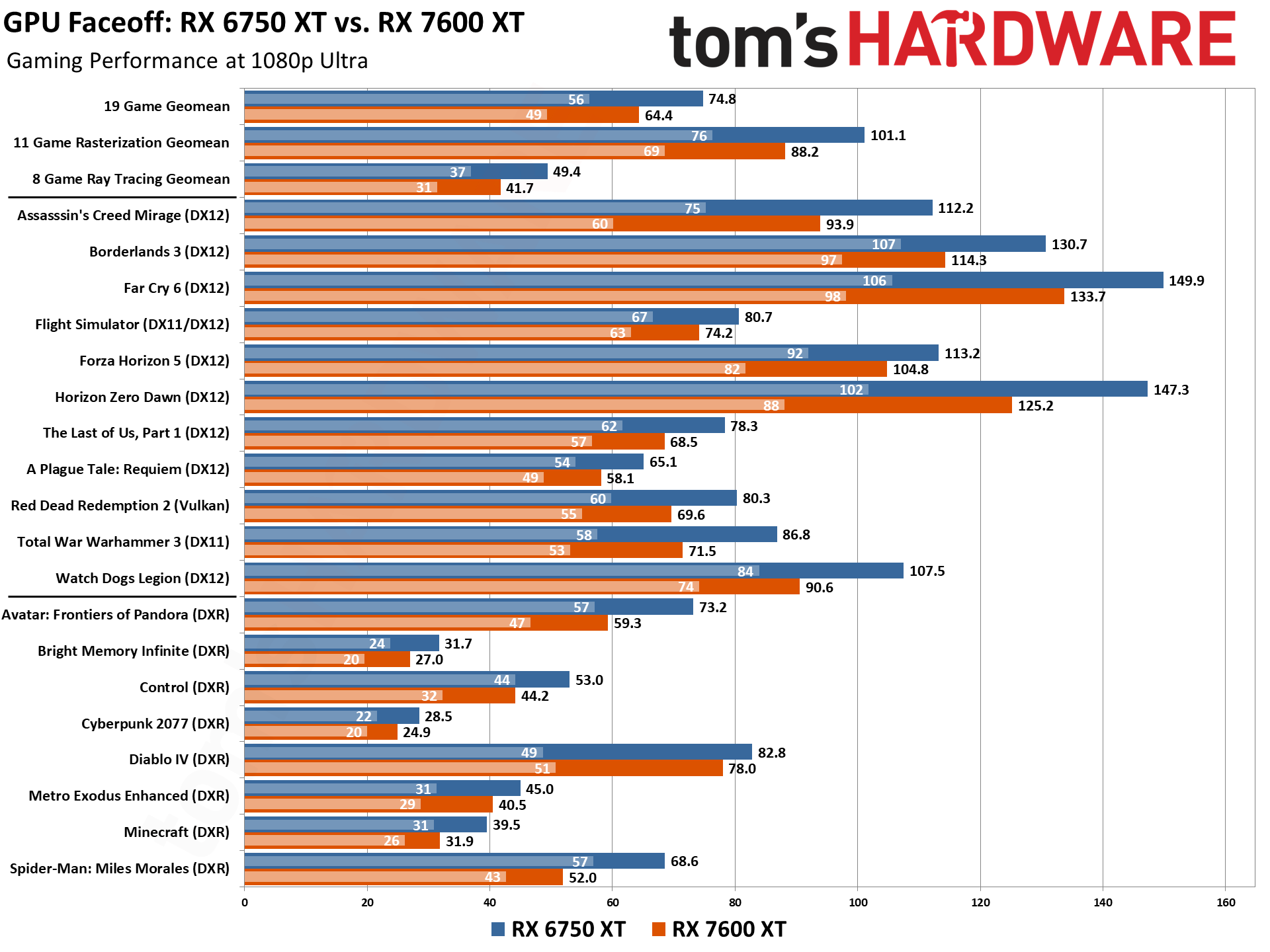
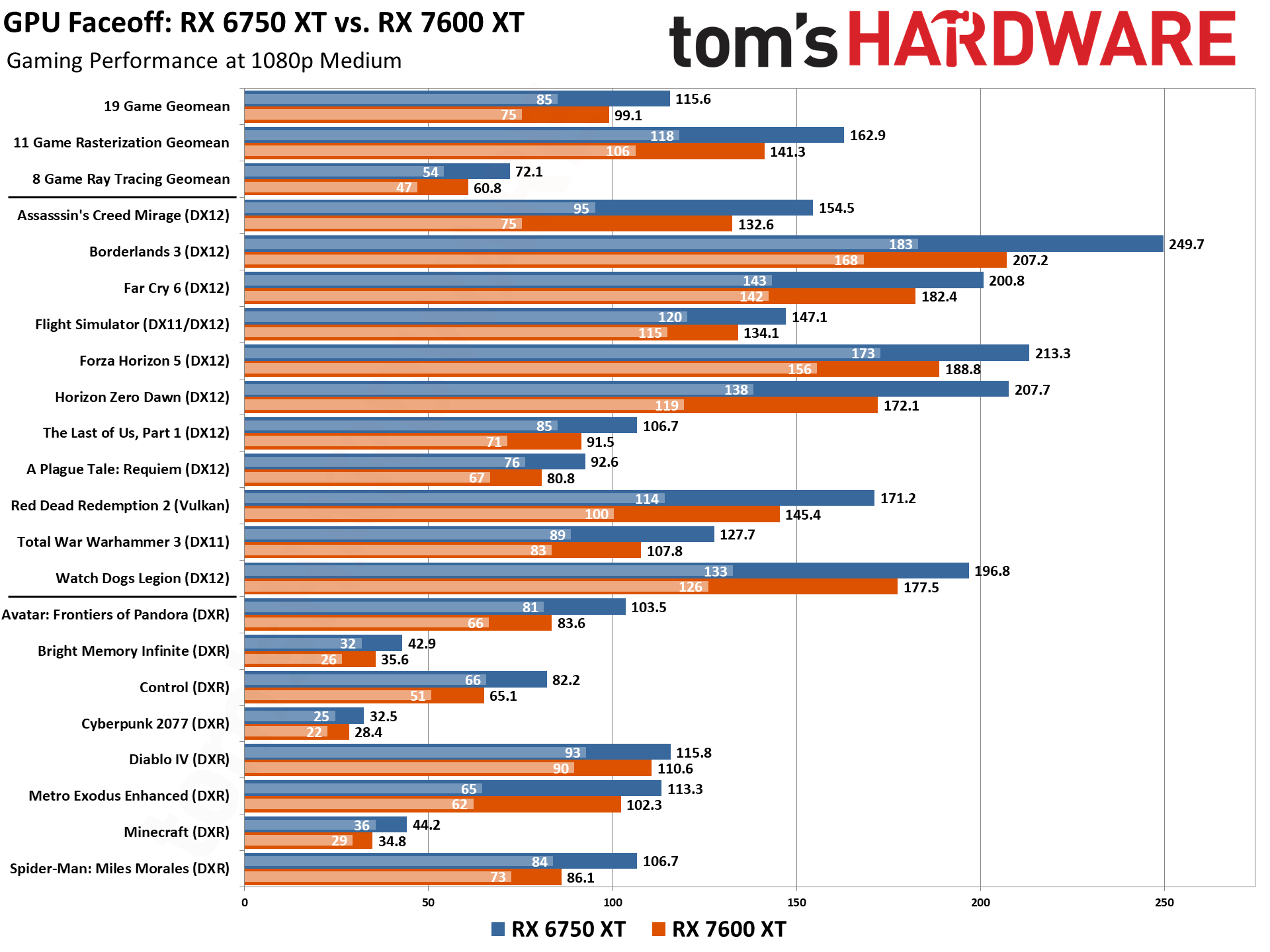
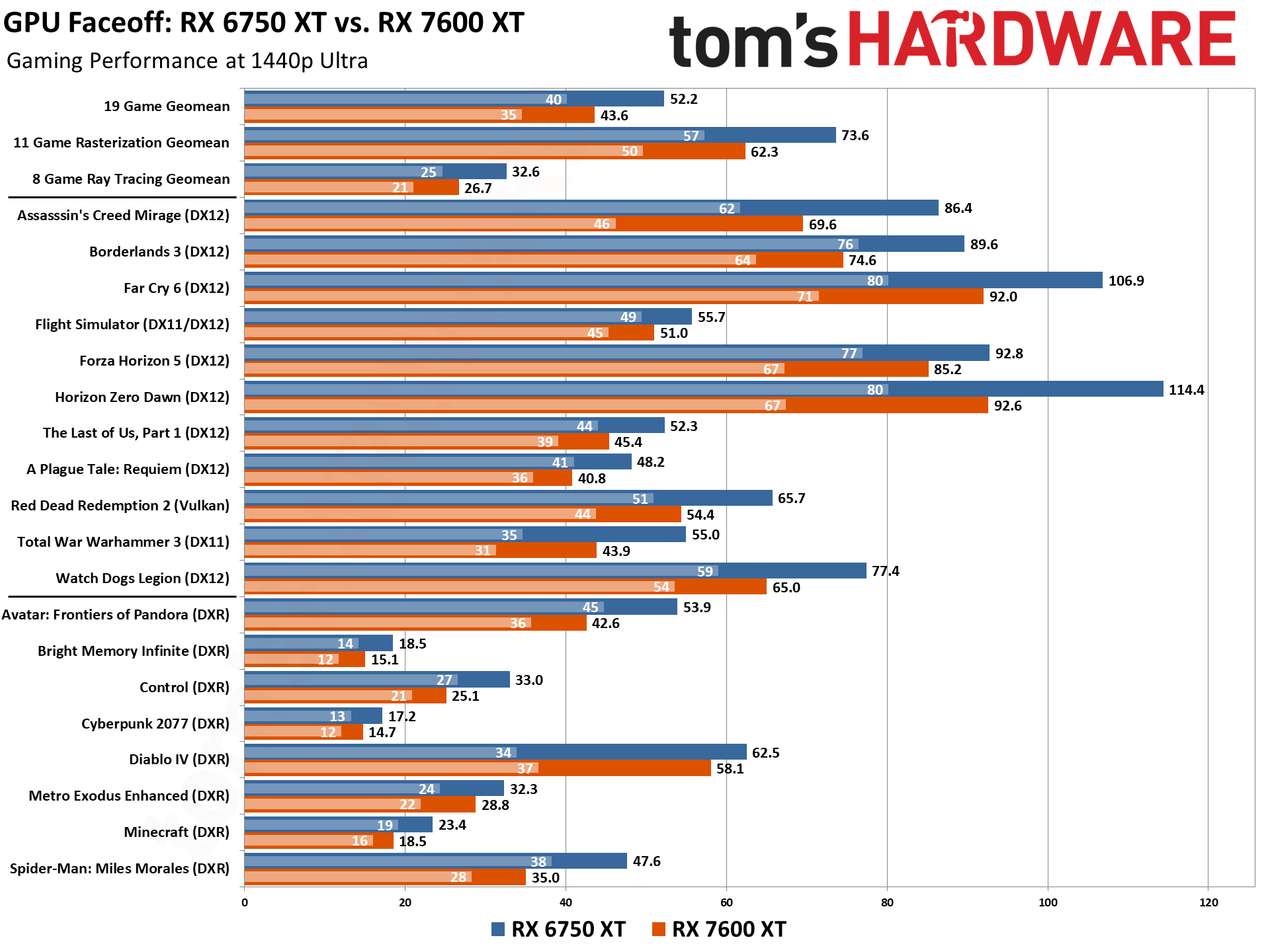
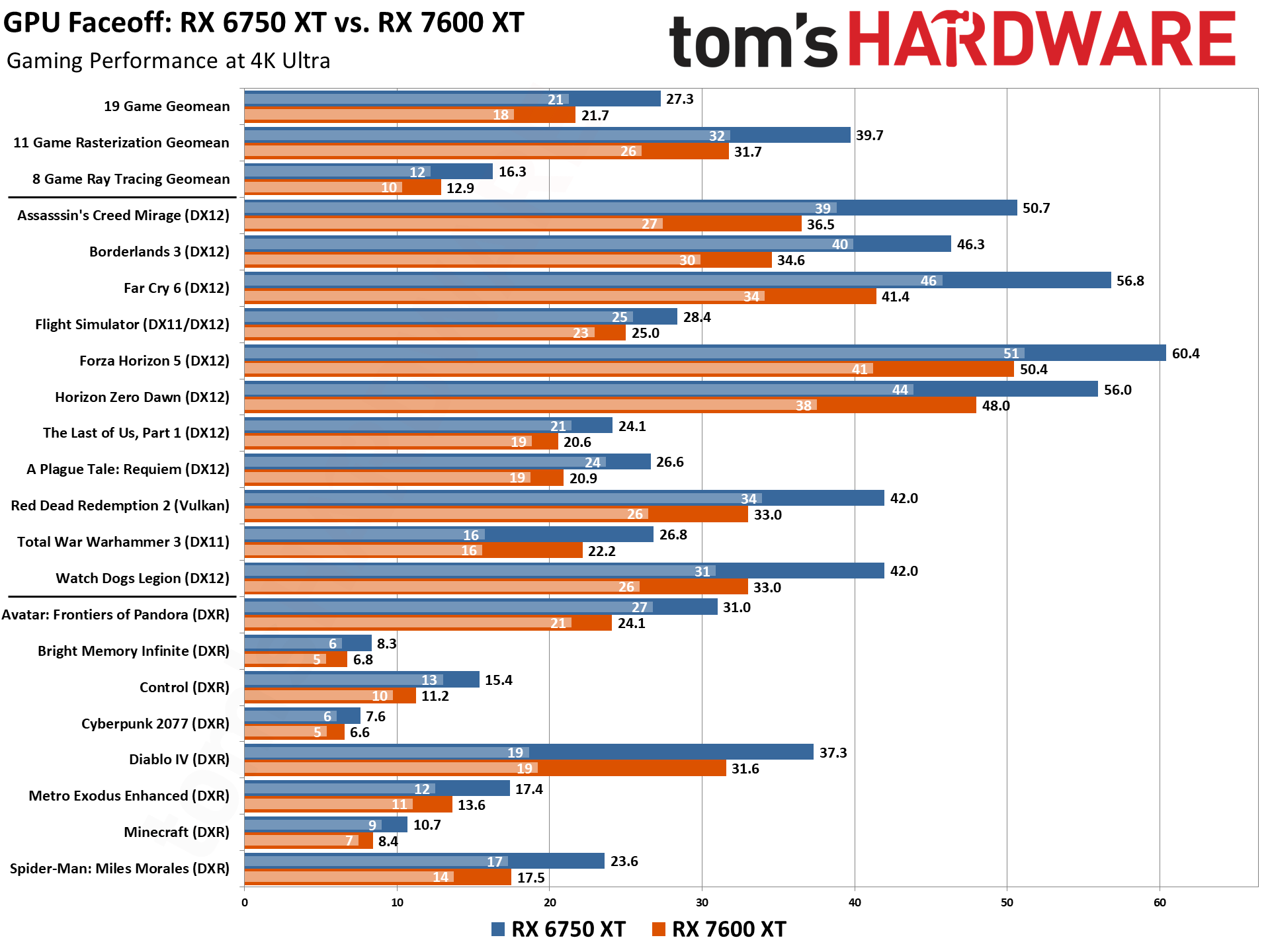
Our performance benchmarks show the RX 6750 XT significantly outpaces the RX 7600 XT, despite being on an older GPU architecture and having less VRAM. There's not a single instance in our test suite — which consists of 19 games at four different settings/resolution combinations, for 76 total results — where the 7600 XT can claim a win. In fact, the closest results are generally at lower settings where CPU bottlenecks start to show up.
We'll cover the features that make this happen in a moment, but in short the 6750 XT has more CUs (Compute Units) and a 50% wider memory interface, giving it more raw bandwidth as well. Overall, zooming out to the overall picture, the 6750 XT ends up being around 20% faster than the 7600 XT.
At 1080p medium, the RX 6750 XT beats the RX 7600 XT by 16% on average. Looking just at rasterized games, the RX 6750 XT is 15% faster, and focusing on ray tracing titles gives it an 18% lead. 1080p ultra yields the same results, with a 16% lead overall, 15% in rasterization games, and 19% in RT games. And the gap only gets wider at higher resolutions.
Despite having less total VRAM, the RX 6750 XT extends its lead to 20% overall at 1440p ultra (18% in rasterization and 22% in ray tracing games). And then at 4K, we get the widest gap of all, with a 25% lead overall, and also 25% for the rasterization games and 26% for ray tracing games.
There's not much else to say regarding the individual gaming results. There's the usual margins, with the closest results being about 10% in favor of the 6750, and the biggest gaps sit at around 40%. The reasons tend to come from the underlying architectures and specs, as well as potential CPU limitations. With 25% more CUs and 50% more memory bandwidth, games that lean more heavily on compute tend to be closer while those that benefit from raw bandwidth will be further apart — which explains why 4K favors the 6750 the most, as high resolutions often hit bandwidth harder.
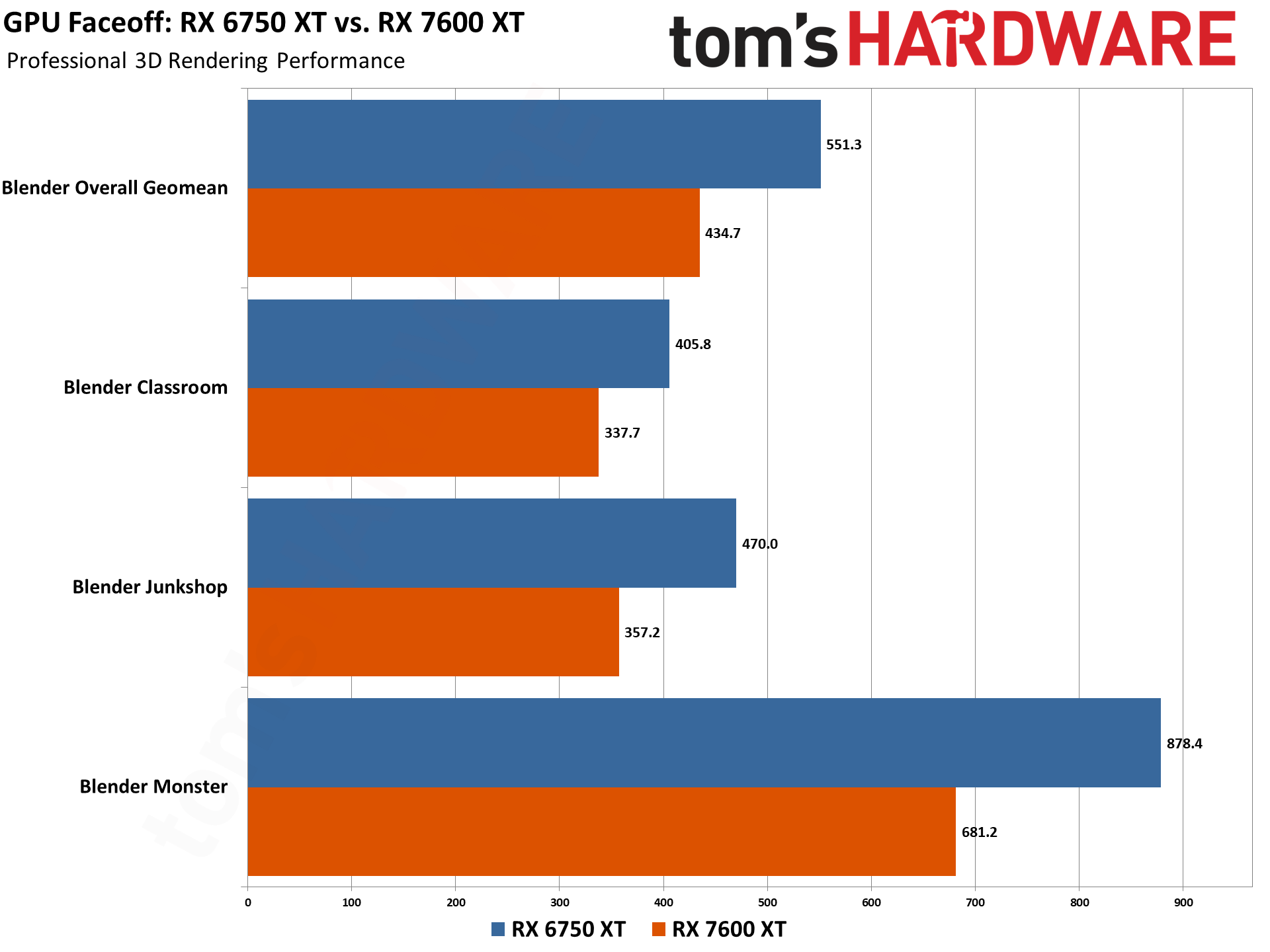
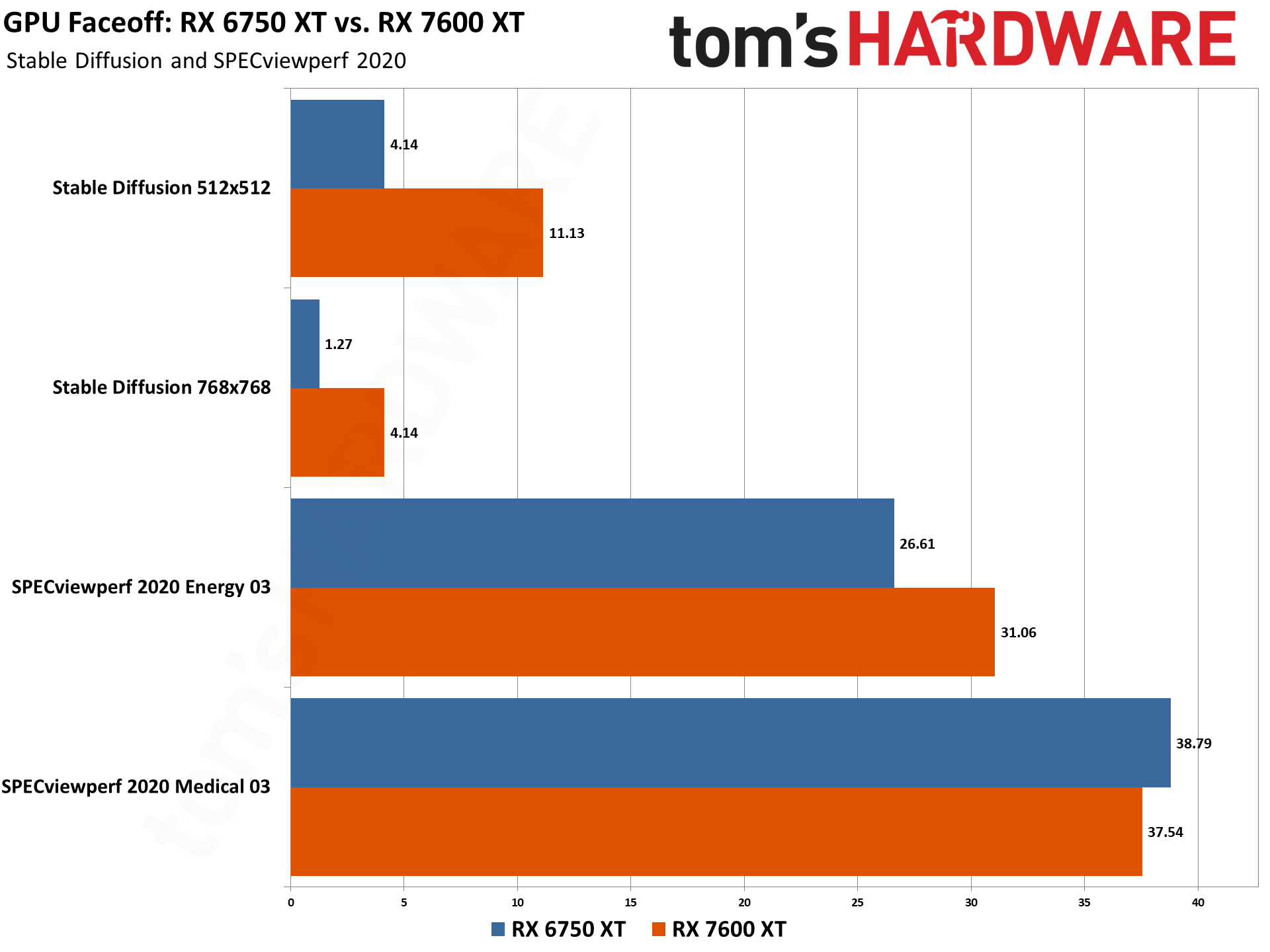
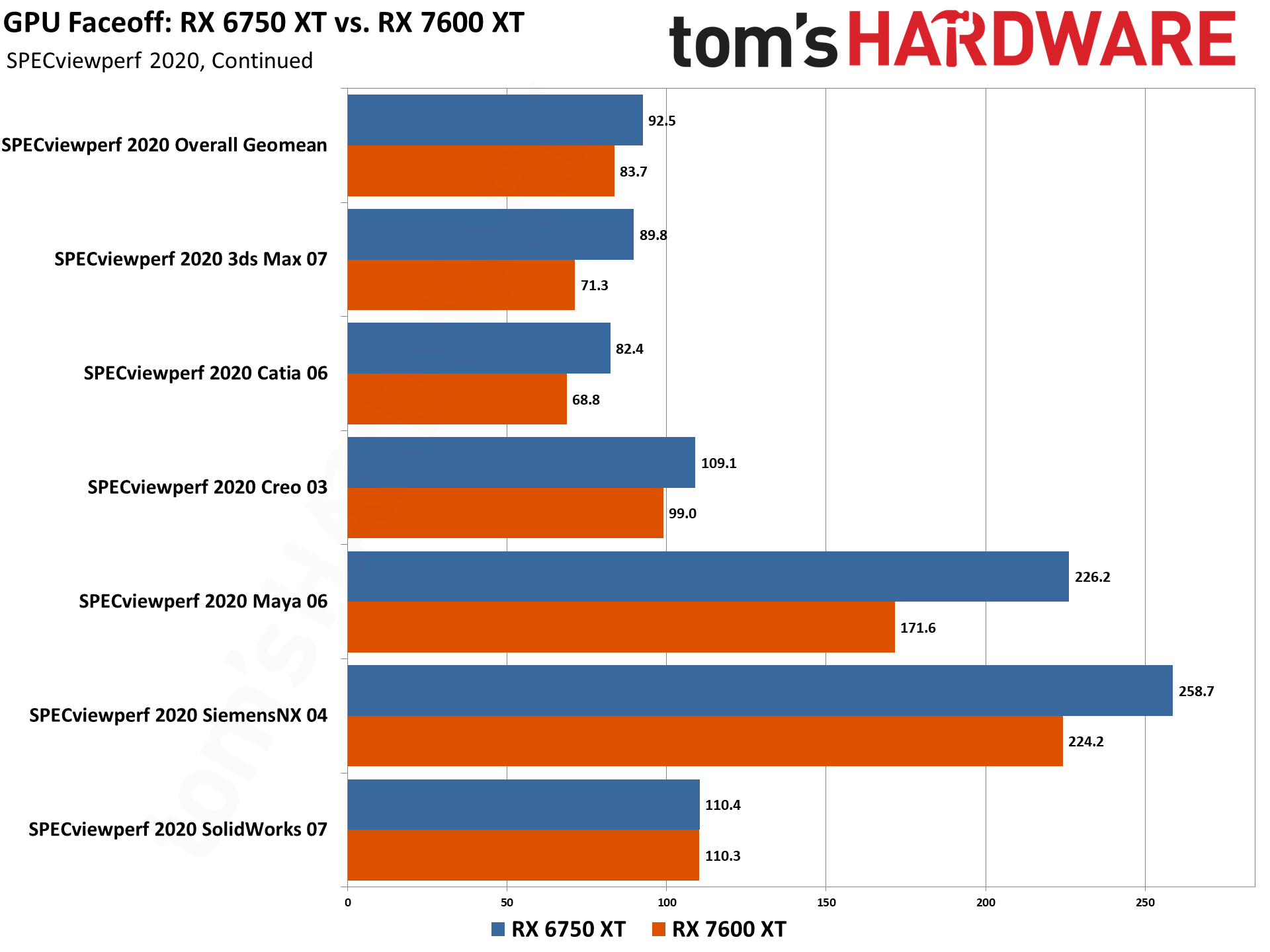
Unsurprisingly, the RX 6750 XT's gaming performance behavior also extends into productivity applications. in blender we saw the RX 6750 XT outperform the RX 7600 XT by 27% on average. In our overall geomean for Specviewperf 2020, the RX 6750 XT was 10% faster. This wide variance is pretty typical in productivity applications, some applications take advantage of certain instructions more than others, yielding different performance margins.
The only real exception to the performance advantage is our Stable Diffusion testing. RDNA 3 GPUs have WMMA (Wave Matrix Multiply Accumulate) instructions that boost FP16 throughput, and there's been a distinct lack of tuning for RDNA 2 GPUs in AI applications. Our test results give the 7600 XT up to a 3X advantage at 768x768, though on paper it shouldn't be quite that wide.
Performance Winner: RX 6750 XT
The RX 6750 XT is the winner in this part of the faceoff. Despite being a generation behind and with 25% less VRAM, the older GPU outperforms the RX 7600 XT nearly everywhere. It wins by a large margin in gaming applications, whether with rasterization or ray tracing, as well as most productivity applications. Given the wide gap, we're assigning two points to the 6750 XT for this category.
RX 7600 XT vs RX 6750 XT: Price
As mentioned at the start of this faceoff, pricing for the RX 7600 XT is nearly the same as the RX 6750 XT. But "nearly" isn't "identical" and the street prices do generally favor the 6750, at least if you're after the least expensive cards. Street pricing can fluctuate quite a bit, but in general, pricing of RX 7600 XT AIB partner cards are within about $20 of equivalent RX 6750 XT variants.
The cheapest RX 7600 XT cards at present are the ASRock RX 7600 XT Challenger OC, Gigabyte RX 7600 XT Gaming OC, and XFX Speedster SWFT 210 all going for $319.99, though we've seen sales drop the 7600 XT as low as $299. The least expensive RX 6750 XT right now is the ASRock Challenger Pro OC at $299.97. 'Premium' AIB partner options for both GPUs can cost as much as $350 to $370, but unless you're really after more RGB lighting, they won't add much in the way of performance (typically 1~3 percent).
Considering the performance advantage that the RX 6750 XT offers, having the RX 7600 XT cost $20 more is not in a great spot for the newer GPU from a value perspective. Nearly anyone who's serious about playing games will find the 6750 XT to be the substantially better choice, both from a raw performance as well as a performance per dollar metric.
For the RX 7600 XT to be competitive, the RDNA 3 GPU really needs to be priced $25–$50 below the RX 6750 XT. Incidentally, the lowest prices that we've ever seen for the two GPUs are RX 6750 XT at $279 and $288 for the RX 7600 XT, which you can see in our GPU Price Index. The best hope for the 7600 XT would be for RDNA 2 cards to simply go away, but that's not likely to happen, not before future RDNA 4 cards start to arrive.
The only thing going against the RX 6750 XT is its age. The RX 7600 XT is new and thus should have pretty consistent pricing for the next few years, with a slow downward trend. The RX 6750 XT has been around for over two years, it's almost certainly no longer being actively manufactured, and so the retail parts being sold are basically it — once they're gone, you'd need to look at used cards. So, in the coming days we could see more volatility on the 6750 XT prices, but as long as cards are available for about the same price as the 7600 XT, it's the better pick.
Pricing Winner: RX 6750 XT
The RX 6750 XT wins this category given its current and recent price history, as well as the value on tap. The fact that the RX 6750 XT performs better than the RX 7600 XT for the same price gives it a better performance per dollar ratio. Even differences in electricity cost (which we'll cover below) won't really alter the pricing story.
RX 7600 XT vs RX 6750 XT: Features, Technology, and Software
Digging into the hardware specs, the RX 7600 XT may have a newer architecture than the RX 6750 XT, but there are areas where the two GPUs overlap and other aspects that downright favor the older GPU.
The RX 7600 XT is based on AMD's entry-level Navi 33 die and features 2,048 shader cores, 32 CUs, 32MB of Infinity Cache, and 16GB of memory on a 128-bit bus — with 4GB per 32-bit channel. The RX 6750 XT uses AMD's higher-end Navi 22 die that comes with 2,560 shader cores, 40 CUs, and 12GB of memory operating on a 192-bit wide bus with a 96MB L3 cache. Navi 22 uses TSMC's N7 7nm-class process node, while Navi 33 uses TSMC's N6 refinement that's still a 7nm-class node, so there's only a minor improvement in density and power characteristics with the newer Navi 33 chip.
As noted above, the 7600 XT also has 33% less raw memory bandwidth thanks to its narrower memory interface, but it also has one third as much L3 Infinity Cache. That means fewer cache hits and thus proportionally less effective bandwidth as well. The7600 XT also has fewer CUs and GPU shaders, though here things take an interesting turn.
The RDNA 3 CUs can do twice the compute per CU, at least on paper. This rarely seems to show up in games, but it does give the 7600 XT more raw compute in theory — 22.6 teraflops FP32 versus 13.3 on the 6750 XT. In games, the RDNA 3 chips generally behave as though they don't have that doubled FP, however, so the 7600 XT behaves more like an 11.8 teraflops GPU.
Ultimately, this large disparity in CUs and bandwidth contributes to the RX 7600 XT's inability to outperform the 6750 XT in gaming scenarios despite having a newer GPU architecture. The RX 7600 XT has 512 fewer cores and 8 less CUs than the 6750 XT, with 33% less memory bandwidth.
The only aspect of the memory subsystem where the RX 7600 XT comes out ahead is VRAM capacity, featuring 16GB of VRAM. There are limited scenarios where the extra memory helps, like AI large language models, and sometimes (maybe) at 4K gaming with maxed out settings. In practice, we haven't had much in the way of games that push beyond 12GB of VRAM use, and that's unlikely to change until the next generation console hardware arrives with presumably more memory.
The Infinity Cache capacity is also significantly down on the RX 7600 XT with just 32MB compared to the RX 6750 XT's 96MB of cache. However, this difference is not as bad as it seems on paper. RDNA 3 received significant design changes to its caching design, with all RDNA 3 GPUs configured to have less capacity in general. This reduction was offset by bandwidth improvements to the L1, L2, and Infinity Cache in RDNA 3, so 32MB does better than the numbers might suggest. However, there's still a big capacity difference — the RX 7700 XT is the technical successor to the 6750 XT, with 64MB of L3 cache, and you can see how the RX 7700 XT vs RX 6750 XT GPU faceoff played out (TLDR: 7700 XT easily wins).
Most of the fundamental GPU building blocks are similar enough between RDNA 2 and RDNA 3 that the 7600 XT doesn't see any major technological advantages. There are two exceptions, however. First, it supports AMD's newer video codec unit, with hardware support for AV1 encoding and decoding. Second, it has support for DisplayPort 2.1 UHBR13.5 output.
The second of those proves less important than the first, as you can largely get the same experience from HDMI 2.1, and mostly the same from DisplayPort 1.4a with DSC (Display Stream Compression). The number of DP2.1 monitors remains quite limited, and while that will improve over time, chances are you're going to use both the RX 6750 XT and RX 7600 XT with an existing monitor that lacks DP2.1 support.
The improved video codec block is a bit harder to come to a firm conclusion as to how important it is, and that will largely depend on the user. RDNA 2 has HEVC (aka H.265) encoding and decoding support, and in practice HEVC looks nearly the same as AV1 content — it's just at AV1 was designed to be royalty free. RDNA 2 can also decode AV1 content (some of the work gets done on shaders or in the CPU, but it still happens at well over 4K60 rates), so it basically boils down to whether you want to use AV1 hardware encoding — usually for stuff like Twitch streaming. If you do, you'll be better off with the 7600 XT or 7700 XT, but we think most people will be fine without AV1 encoding support.
Software-wise, there's virtually no difference between the two GPUs. The previous generation RX 6750 XT still has full support from AMD drivers. The vast majority of AMD's software and technology works with the RX 6750 XT, including Anti-Lag, FSR 2/3, and Hyper-RX. There are only a couple of features that are RX 7000 exclusive, but so far these don't impact gamers in any significant way.
Features, Technology, and Software Winner: Tie
The RX 7600 XT has a newer architecture, but the RX 6750 XT comes with significantly more cores and memory bandwidth to counteract RDNA 3's architectural enhancements. RDNA 3 can be better in some compute-limited workloads like AI (e.g. Stable Diffusion), and it has AV1 support along with DP2.1. That's not enough to fully overcome the higher raw specs, so we're calling this category a tie.
RX 7600 XT vs RX 6750 XT: Power Efficiency
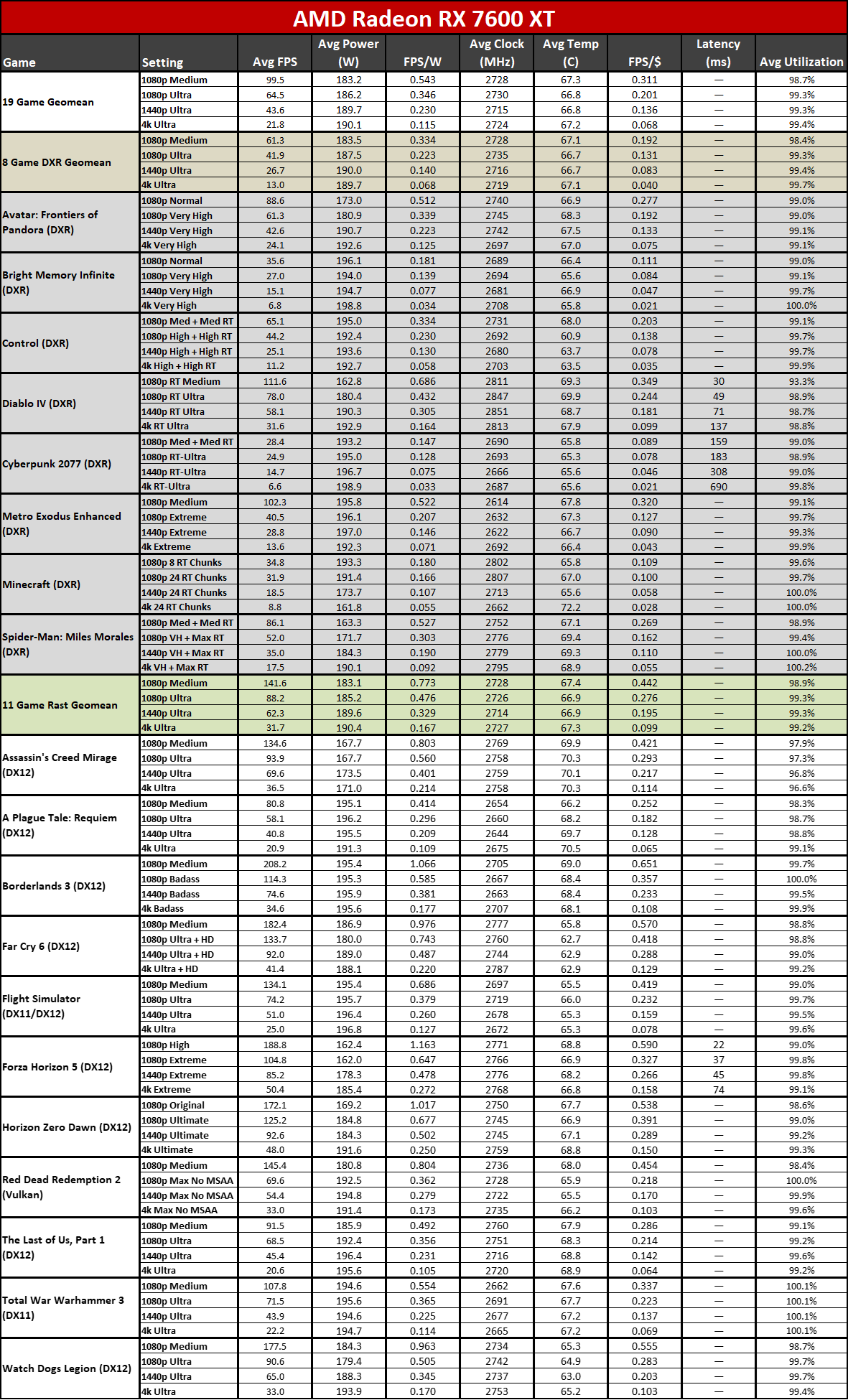
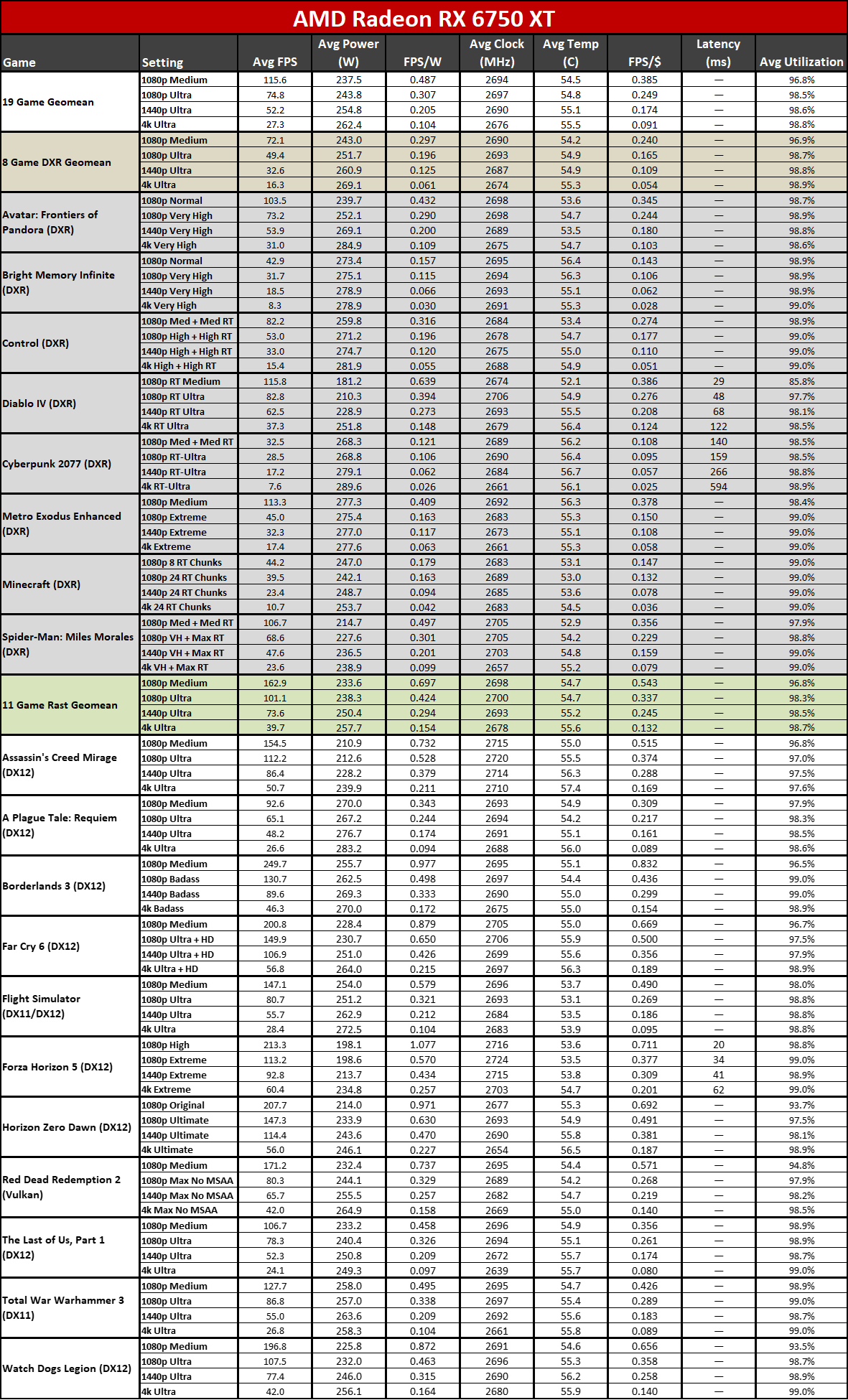
The above tables show the full performance and power data for our test suite, along with some other details, including power efficiency (FPS/W) and value (FPS/$). Our focus here will be on power use as well as performance per watt, i.e. efficiency.
Power use favors the RX 7600 XT by anywhere from 54W to 72W on average, with the higher values coming at higher resolutions. It's a pretty decent gap in power use, with the 6750 XT drawing around 33% more power overall, but when converted to efficiency the two chips are much closer.
TSMC N6 does have some advantages, and having a narrower memory interface width also reduces the power load. Overall efficiency favors the RX 7600 XT by 12% across all of our testing. That's basically in line with guidance from TSMC on its N6 node.
Looking at the average power use, the 7600 consumes 183.2 watts at 1080p medium, 186.2 watts at 1080p ultra, 189.7 watts at 1440p ultra, and 190.1 watts at 4k ultra. Those are pretty consistent across our four settings, indicating the GPU is mostly hitting its performance limits. The RX 6750 XT pulls 237.5W, 243.8W, 254.8W, and 262.4W at the same four settings, so there's more of a CPU bottleneck at 1080p that reduces the GPU load.
Talking about power efficiency as a whole doesn't make as much sense. FPS will change dramatically at higher settings, and thus FPS/W drops a lot. But the comparative efficiency at each level is still consistent, with the 7600 XT offering 12–13 percent better performance per watt at 1080p and 1440p, and that drops to a 10% advantage at 4K. It's not a massive difference, but it is an advantage to the RDNA 3 GPU regardless.
Power Efficiency Winner: RX 7600 XT
The RX 7600 XT finally gets a clear victory in one of our four metrics. The RDNA 3 GPU is not only less power hungry but also is more power efficient than the RX 6750 XT. But while the win here is good to see, it's also important to keep things in perspective: Nvidia's efficiency gains (FPS/W) with its RTX 40-series GPUs are typically in the 50~60 percent range. That's because Nvidia fully moved to a newer 5nm-class TSMC 4N node, which was effectively a 1.5 step improvement from Samsung's 8N (10nm-class), rather than a half-step refinement.

RX 7600 XT vs RX 6750 XT Verdict
The RX 6750 XT easily comes out as the winner in this faceoff against the RX 7600 XT, matching or beating the newer price-competitive offering in three out of four categories. Plain and simple, the RX 6750 XT's far more robust hardware specifications make it the better choice for the vast majority of PC users, and gamers in particular should greatly favor the older GPU over the newer lackluster option.
As expected, the RX 7600 XT's VRAM advantage did virtually nothing to offset the difference in performance between the two GPUs. Even at 4K, where higher VRAM capacity usually matters more, the very limited 128-bit memory interface holds the 7600 XT back. If the primary selling point of the RX 7600 XT is its large 16GB capacity, the only significant difference from its lower-end RX 7600 8GB sibling, then you need a very specific use case for the card to make sense.
AI workloads are one potentially interesting option, but the problem there is that AMD's AI performance on lower tier RDNA 3 GPUs still fails to impress. Don't even get us started about the lack of ROCm and HIP support for anything other than Navi 31 GPUs right now, and never mind the fact that an RTX 3060 Ti can outperform everything below the RX 7900 XT in our Stable Diffusion testing. Basically, focusing on AI performance with the 7600 XT is like focusing purely on whether a vehicle offers power steering and power windows — never mind handling, acceleration, or other aspects.
In the case of the 7600 XT, there simply aren't enough cases where the 16GB capacity is practically useful. Games today typically don't need more than 12GB at most to run at maximum graphical settings and 4K, and usually only 10GB or 8GB at 1440p and 1080p, respectively. In the edge cases where a game might benefit from having more than 12GB, like 4K ultra, the RX 7600 XT's relatively weak 2,048 shader cores mean it lacks the horsepower to run effectively anyway.
With the main benefits of RDNA 3 being its AI accelerators, AV1 encoding, and DisplayPort 2.1 output — in order of importance — the RX 7600 XT ends up looking like a solution in search of a problem. Yes, it costs less than the RX 7700 XT, but the latter provides a significant 50% improvement in performance, and the older RX 6750 XT provides 20–25 percent more performance for the same price.
The RX 6750 XT ends up as the more well-rounded GPU. It might be two years older than the RX 7600 XT and slightly less efficient, but the new mainstream-budget model fails to beat the discounted previous generation upper-mainstream card in all the ways that truly matter. The RDNA 4 RX 8000-series GPUs are on the horizon, likely coming out in early 2025, but we probably won't see a new $300-class part from AMD for quite a while. Only time can tell how long the RX 6750 XT will remain in the supply chain, but while it lasts, it remains a competitive offering in the current market climate.







